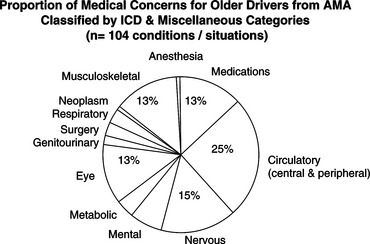Chapter 20 Older Drivers with Acute or Chronic Medical Conditions (Includes Noncommercial Motor Vehicles, Excludes Commercial Drivers)
The primary guideline for assessing and counseling older drivers is set forth by the American Medical Association (AMA)1 in conjunction with the National Highway Traffic Safety Administration (NHTSA). Older drivers are at greater risk for fatal crashes because of their fragility. Three important areas that tend to decline in function in older drivers are (1) vision, (2) cognition, and (3) motor function.2
Red flags (listed below) indicate a medical condition in need of further evaluation or management. These concerns may be observed from patient behavior, witnessed during acute events, or noted in a patient’s medical history.1 The complete list of medical concerns with detailed explanations can be found at the AMA web site (http://www.ama-assn.org/ama/pub/category/1079.html).
RED FLAGS AND CONTRAINDICATIONS FOR DRIVING
E00-E90 ENDOCRINE, NUTRITIONAL, AND METABOLIC DISEASES
F00-F99 MENTAL AND BEHAVIORAL DISORDERS
G00-G99 DISEASES OF THE NERVOUS SYSTEM
< div class='tao-gold-member'>
Stay updated, free articles. Join our Telegram channel

Full access? Get Clinical Tree














